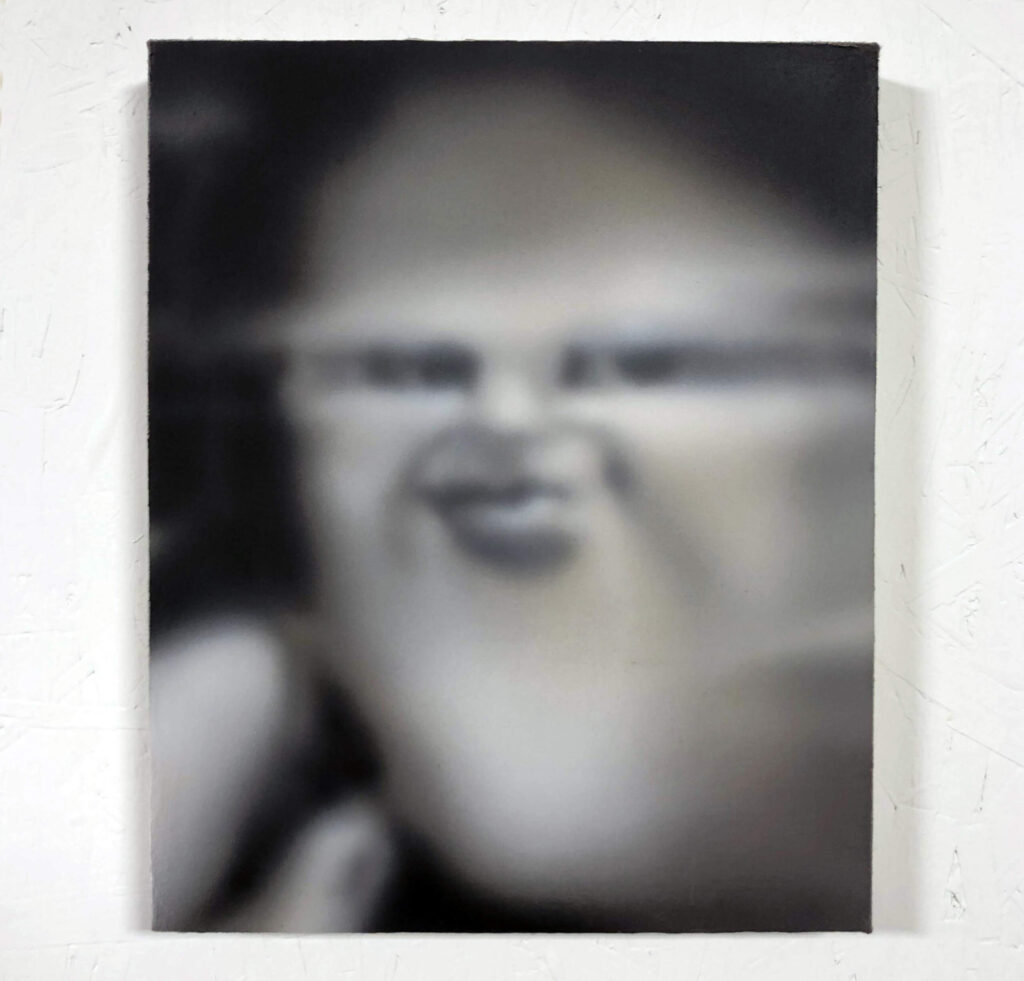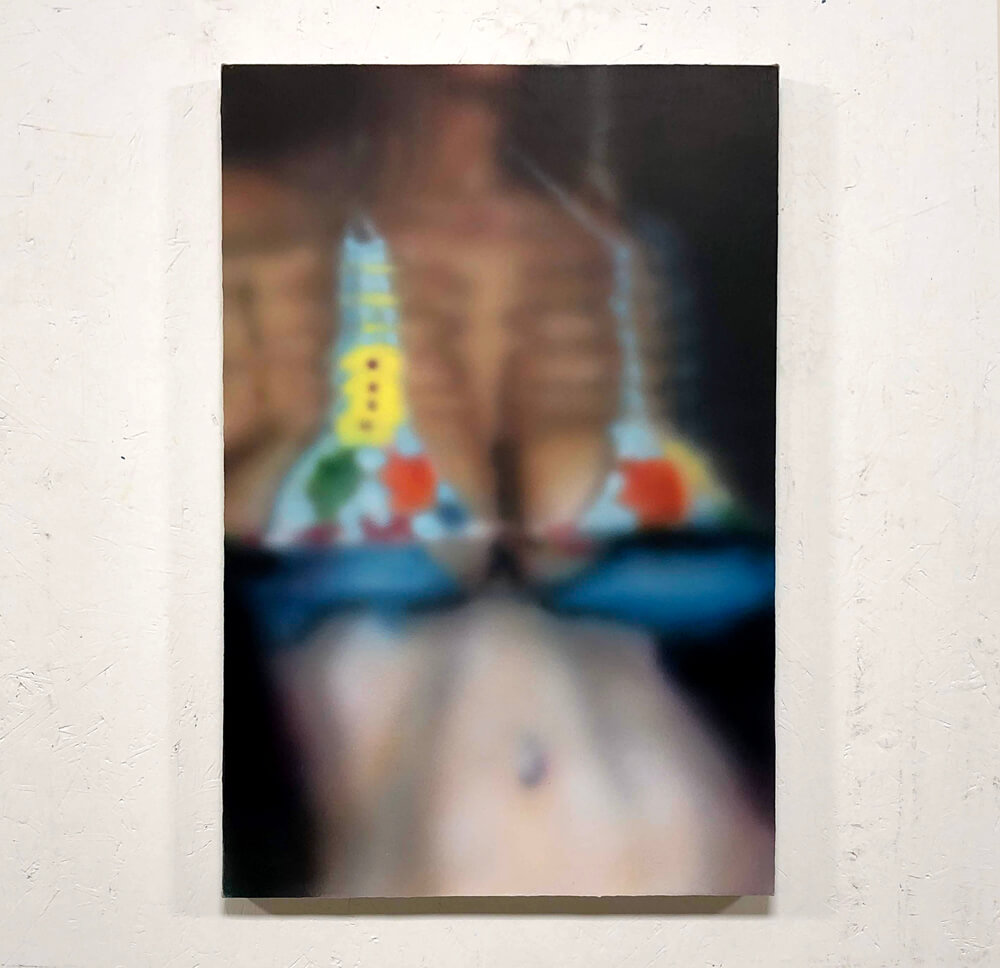Profile of the Week: Morgan Buck

We connected with Morgan Buck, an artist based in Portland, Oregon on FRONTRUNNER’s social site to talk to him about the evolution of his art, and his creative inspirations. Morgan’s work was born out of a fascination with glitchy panoramic pictures, which has shaped his current creative process. It starts with an image from the Internet, and ends in a carefully and skillfully airbrushed painting of the photographically transformed image. Every step is intentional, which is a testament to Morgan’s passion for his craft in and of itself.
When did you start your art practice?
I first started painting in 2005 when I was in community college. I started doing really surreal kinda Dali inspired stuff early on. I started getting tuition waivers and winning every student art show and started to believe it was something I could do. I went to Pacific Northwest College of Art in 2007 and began dealing more direct with self portraiture and very provocative subject matter. It was really pretty tongue in cheek art, and the politics of the work were pretty ‘dickish’, but it’s one of the more formative periods of my development where I made a bunch of mistakes. It was my bad boy phase. After getting suspended and almost expelled for one of my paintings, I began questioning my impulses and thinking a bit more critically about self expression. There’s a bunch of phases and years that led me to where I am now, but that was the beginning of the question. How do I make crazy sh*t without being self indulgent?

Acrylic on canvas
12″ x 15″
How do you describe your vision for your work?
My work now is a more detached self expression. My vision is to find my imagination elsewhere rather than inside my head, and render the paintings as a mysteriously referenced thing. I use a process to take existing images and transform them into ideas that I never would have thought about until I made that transformation.
How has your work evolved over time?
The current work’s lineage really began when I started messing with cellphone panorama glitch with a macro lens on a road trip with a photographer friend in the spring of 2016. Everyone has waved their cellphone around while making a panorama and made trippy glitch images happen. My friend had a 10x jewelers loupe that he used as a macro lens for his cellphone. We were stopped in Nevada in a diner near Area 51 and I started messing with his lens and started making these images that looked very alien and classified as f*ck. Within a few minutes I had asked him for his cellphone and started doing the lens panoramas of images on the internet. Adding the internet as a source for images made it unlimited by my personal experience. This basic process is the image source for all of my paintings these days.

Acrylic on canvas
19.5″ x 30″
When I first started these images I was in an anti-painting phase, and very tired of conventional painting process and materiality. I had been doing what I called “Crumple Paintings” which were canvases that were sewn onto chicken wire so that they could be warped and crumpled, painted into, then warped and crumpled more, then repeat. They created these sculptural paintings that were very bizarre, had a body language and a multifaceted pictorial quality that was somewhat unique. However, they took too much energy and my moves on them had seriously started to stagnate. For this reason, the idea of just photo printing these panorama images was very exciting and fresh to me at the time.
After a year of just doing these images printed I participated in the Pilotenkuche artist residency in Liepzig Germany. I didn’t have access to printers like I did in Portland. I managed to print some, but I was surrounded by a bunch of other painters in the residency, and like the conformist poseur I am, I gave in to peer pressure and started to paint the images rather than print them. What I found was that the paintings required no explanation. People understood them, or felt like they understood them immediately, where as the prints appeared more unconventional, but were obviously some digital media experiment of some kind. The prints required an explanation that the paintings did not.

Acrylic on canvas
48″ x 52″
When I got back home to Portland and started painting again, the work started to look too much like a conventional painting with amped up colors and painterly brush strokes. The paintings looked too much like how I paint and was so bored with. So I just went for the airbrush and painted as directly from the photo as I could while editing out all the digital noise of glitches and pixels that would put it into a post internet dialogue. The painting “Baby Fat” was the first painting that I did like this. I painted it in four hours and stared at it for even more hours after words. It was the dopest painting I had ever done till that point, and pretty much everyone who saw it agreed. It just looked so fresh, that flat dusty marshmallow matte surface, and so bloated was the subject matter submerging into that shallow space and blurry vignette. I had never seen anything quite like it. I have made over 70 of these paintings last time I counted, and am still excited to make more.
What are your artistic/creative inspirations?
I’m most inspired by things that I’ve never thought of before. A kind of alien aesthetic, but not sci-fi. Since grad school I have wanted to paint in a detached non human way. I’ve read a little about OOO, but I can’t be that dogmatic about what I do. I’m human and love to paint. My current work is a kind of happy middle. Put simply, I like weird and very well made stuff.
Christian Rex Van Minnen is probably my favorite artist right now. He’s doing all kinds of layering of images and content in this sort of Arcimbaldoesque pop surrealism with tattooed skin and gummy fruit. His stuff just gets weirder and weirder, but his painting technique is constantly flawless. His color and contrast in his work is always screaming! Very pop surrealism, but without ruining it by throwing in a Mickey Mouse or a Ronald McDonald. I absolutely love his stuff.
Tell me about your process.
My process is surfing the internet for images to transform. I look for images that have strange and particular features and are strong images formally to begin with. If the images are weak or too low contrast they just start to become muddy when I start to manipulate them. Mostly it’s Google and occasionally Instagram. I will pull up the image on my laptop and use my cellphone panorama and my 10x magnifying lens to photograph the image off of the laptop screen. I will shoot the same image over and over again until it starts to do something that feels intentional, or dramatically changes the read of the original image. Then I print the images and use the print as a reference for my airbrush paintings. The airbrush is great, because it makes a photographic blur so naturally and it’s another layer obscuring the origin of the image. While painting, I edit out the glitchiness and the pixelation in the translation of the image. Many people are confused by the medium of my work. I often get asked where I get them printed at, and people are surprised when I tell them that they’re painted. That’s always a goal of mine.

Acrylic on canvas
37″ x 65″
Do you think your work has a message? How is it received?
To send a message is not why I got into the art game. There’s no real message in my work.
What is safe and/or dangerous in terms of experimentation?
First of all, experimentation is usually a very safe space. You don’t have to commit to anything. Artists tend to associate experimentation with play because it’s uncritical. It’s only when you start to get into a consistent mode of work that you start betting years of time and money on something that you believe in at the time when real risk starts to occur. A few years down the road your art can lead to nowhere and you find that you’ve wasted your time and disappointed yourself. Consistent art production is the most common risk. A very financially grandiose or public experiment can also be risky, also because it can risk money and reputation. Usually though failure is not real or even on the table with “experiments,” because experiments teach you something without wasting too much time if you are truly experimenting and not just saying you are to seem edgy. There’s no right or wrong answer, there’s just results. What you do with the results can have more consequences.

Where would you like to see your work in 3 years? What goals do you have for your practice?
I’m always very focused on just being the best painter that I can be. That’s always my main goal. I alway’s think about the old masters and how they just painted a bowl of fruit, but just did it so f*cking well that people still talk about them. Quality holds up more than being relevant to a fleeting cultural moment. We’re so culturally saturated in our current time that that is very difficult for people to see. That said, I’m not painting fruit.
As for my career goals, I live in Portland Oregon, so I know no one’s going to buy my work or give me that good of an opportunity to show no matter how great my work is. I’m also a white straight guy, so there’s no timely political incentive for curators to show me. That said, I live in a badass house, drive a nice car, have a beautiful girlfriend, have no debt, have a decent job that doesn’t bore me, and still find time to paint. Don’t feel sorry for me. I paint, because I love it and it’s a compulsive thing that I will never stop. It’s not about fame, being an influencer, or being a ‘scenester’. I’m really in it for the art only. That said, I would still love to show all over the world and sell work regularly. I definitely have the inventory, but I’m realistic and that’s just a dream at this point. I don’t need any attention to make me believe in myself as an artist. I’d be a sucker if I did.
Are there other emerging artists you can recommend?
Stipan Tadic is a friend of mine who just graduated from Columbia. He’s a very good hardworking painter and illustrator. I met him in Leipzig and we’ve stayed in touch. Seems like he’s starting to get more attention in America these days.
Hwi Hahm is another interesting painter I met in Leipzig who lives in Brooklyn. He does really mysterious paintings and is kind of mysterious as a person, but in a good way. His paintings are kind of like Francis Bacon, but colder, less violent, and more thinking about image translation.
FRONTRUNNER online forum: @morganbuck
Website: morganbuck.net
Instagram: @morgan_buck_
Responses